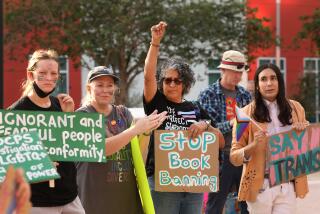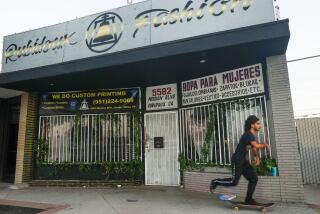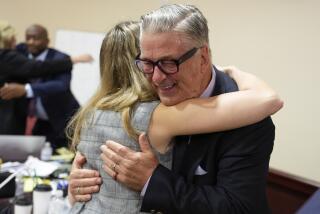Ito Restricts Testimony of FBI Fiber Expert
Responding to the impassioned entreaties of defense attorney Johnnie L. Cochran Jr., Judge Lance A. Ito ruled Thursday that a key prosecution witness in the O.J. Simpson double-murder trial cannot testify about fiber evidence described in a report previously concealed from the former football starâs lawyers.
Ito ruled that FBI hair and fiber expert Doug Deedrick cannot tell jurors that threads found on a knit watch cap left at the crime scene and on a bloody glove discovered on the grounds of Simpsonâs estate almost certainly came from the carpet in Simpsonâs Ford Bronco. Prosecutors contend that Simpson drove the Bronco to his ex-wifeâs condo the night of the murders and then returned home in it.
Although the 6-month-old Simpson trial has often seemed like a continuing tutorial in the intricate ambiguities of Californiaâs reciprocal discovery law, Thursdayâs ruling was the first in which Ito has actually excluded evidence.
But while he ordered prosecutors not to question Deedrick concerning fibers from the Broncoâs carpet, the judge rejected Cochranâs plea that the FBI analyst be precluded from testifying at all. Ito also ruled that the prosecution can use a series of hair and fiber photos that had been withheld from the defense because prosecutors had turned over other pictures of the evidentiary items.
Some of those photos depict the mysterious dark-blue cotton fibers found on Ronald Lyle Goldmanâs bloodstained shirt, the glove found at Simpsonâs house and one of the socks recovered from Simpsonâs bedroom. The clothes worn by the killer of Goldman and Nicole Brown Simpson never have been recovered. However, according to previous testimony, Simpson was wearing dark clothing on the night of the murders.
Legal analysts were divided on the potential impact of Itoâs ruling. âI think itâs a major blow to the prosecution,â said Georgetown law professor Paul Rothstein, who is teaching a course based on the Simpson case. âWhat has been precluded is very important testimony showing the rarity of the fibers.â
Defense attorney Gerald L. Chaleff concurred. âPreclusion is an extreme remedy,â he said. âWhen a judge precludes the use of valuable and important evidence, it is a serious blow to that side.â
But defense attorney Harland W. Braun, a former prosecutor, disagreed. âIt may not be as big a deal as it looks now,â he said. âThere is so much other evidence--blood types, blood patterns, blood trails, a cut on O.J.âs hand. I donât think these fibers will make that big a difference.â
FBI Agentâs Report
Thursdayâs ruling capped a series of events that began late Wednesday afternoon, as Deedrick, the next-to-last witness in the prosecutionâs case, prepared to take the witness stand.
Defense attorneys exploded in objections when Deputy Dist. Atty. Marcia Clark produced a series of graphic boards designed to illustrate Deedrickâs testimony. When it emerged that the defense lawyers had not previously seen the boards and a number of the photos mounted on them, Ito angrily recessed court for the day. He ordered the boards left in the courtroom so that the defense could examine them, and instructed the FBI agent to remain behind to answer any questions that arose.
During the course of that questioning, defense forensic expert Robert Blasier began to suspect that Deedrick had withheld other material to which the defense was entitled. Simpsonâs lawyers asked Ito to rejoin them, and Clark was summoned from her office on another floor of the Criminal Courts Building. The judge then ordered the FBI agent to surrender a notebook he had with him. In it, defense attorneys found a five-page, single-spaced report titled, âThe Search for the Source: Carpet Fibers Found on the Leather Glove and the Knit Hat in the O.J. Simpson Case.â Clark said that she had never seen the report before and that its existence was as much of a surprise to her as it was to the defense.
Discovery of the report set the stage for Thursday morningâs session, which was the stormiest yet in a case that seldom has lacked for heat or hyperbole.
Cochran heaped eloquent invective on Deedrick and the prosecutors, accusing the former of âconcealment and guileâ and the latter of âsanctimonious, pious posturing.â
Simpsonâs lead lawyer accused Clark of manipulating evidence to put the defense at a disadvantage. âThis was more than a mistake,â Cochran said. âThis is calculated. . . . This egregious violation comes as our jury waits, as the [prosecution] case whimpers to a conclusion.â
For her part, Clark accused Cochran of âarguing to this court in bad faith. He is very well aware of the fact that the prosecution did not know about this report until it came to the attention of the defense.â
Ito made no effort to conceal his irritation over the matter. The judge said that when he heard about the carpet fibers discovered on a bloody glove found at Simpsonâs home and on a cap at the murder scene, he wondered where they came from. âIt piqued my interest,â he said, revealing that he asked his clerk, Deirdre Robertson, for pictures of all Ford police vehicles at the scene to see if the carpet fibers might have come from them.
Ito said he learned Wednesday from the FBI agentâs report that the fibers were unique to 1993 and 1994 Broncos. Simpsonâs white Bronco is a 1994 model.
âThis is very compelling evidence,â the judge said. âIt really narrows it down to where the carpet fiber came from.â
He asked Deedrick when he had prepared the report.
âI donât consider it a report,â Deedrick responded from his seat in the courtroom, a few feet behind the prosecution counsel table.
Ito asked icily, âWhen was it completed?â
âSometime this year,â Deedrick said. âI donât remember when.â
Ito persisted, and Deedrick finally said he probably wrote the report âa couple of months ago.â
âI donât care what you call this,â Ito bristled. âThis is a report.â
Near the end of the argument, Clark essentially fell on her sword, as other lawyers have done during the case. âIf the court feels that we have been remiss, then I would urge the court to penalize us personally, myself personally,â she said, lowering her voice, which was husky with emotion. âBut please donât, donât penalize the proof of the case.â
An indignant Cochran brushed aside the prosecutionâs explanation and reminded Ito of his own previous warnings concerning discovery violations. Prosecutors âcan cite you cases as they oftentimes do that are never on point, but Iâm gonna cite you, Ito, on the law. And it says: If it comes to pass that there are reports or conclusions which are reached and there was a deliberate manipulation of the process, [there will] be preclusion.
âYou said that,â Cochran told the judge. âThatâs the relevant law in this courtroom.â
After the hearing, a prosecution source said Itoâs ruling to partially preclude testimony was not a major setback for the district attorneyâs case. âThe bottom lineâ is that Deedrick still can say that the carpet fibers found at the crime scene resemble those from the Bronco, the source said.
However, the importance that prosecutors once attached to Deedrickâs testimony was clear from the fact that Clark took pains to preview it in her opening statement to the jury. âThe value of hair and fiber is a very unique thing,â she said at the time. âA ski cap that was found at the feet of Ron Goldman was examined for hair and trace analysis, and it was found on that hat that there was fiber like those from the carpet of the defendantâs Ford Bronco. Now, stop and think, why would there be carpet fibers like those from the defendantâs Ford Bronco?
âOn the glove found at the defendantâs home at Rockingham, we find hair like those of Nicole Brown, hair like those of Ron Goldman, fibers like those from the shirt of Ron Goldman and fiber like those found in the carpet of the defendantâs Ford Bronco.â
Outside the courtroom Thursday, defense lawyer Peter Neufeld blasted Clarkâs conduct as âgrossly unethical, but she wonât cop to it. She has the temerity to say that she doesnât know her final expert has approximately 100 pages of documents and has done a five-page report.
âAs bad as Clark was,â Neufeld said, âthe FBI agentâs actions are even scarier. The arrogance of that man to suggest his work wasnât a report should scare citizens. When he said he couldnât remember the date of the report, it didnât have the ring of truth. You had a double-barreled assault on the integrity of the proceedings from the FBI and the prosecutors.â
Deedrick took the stand only briefly Thursday, since the court day was cut short by a jurorâs doctorâs appointment. Clark said she expects to conclude her examination of the FBI agent in about a day and a half.
Ruling on Witness
Earlier Thursday, prosecutors said they will conclude their case next week with testimony by Nicole Brown Simpsonâs mother, Juditha Brown, who is expected to recount their final telephone conversation shortly before the murders.
After the jury had left for the day, Ito issued a curt, two-minute ruling that the prosecution does not have to call Thano Peratis, the Los Angeles County Jail nurse who drew blood from Simpson the day after the murders, as a witness. Defense lawyers had argued that Peratis must testify to establish âchain of custodyâ of the blood sample. Otherwise, they said, the prosecution should not be allowed to use DNA tests comparing crime-scene blood with Simpsonâs blood.
But Ito dismissed the defense motion, noting that two LAPD detectives witnessed Peratis drawing the blood and took custody of the vial shortly thereafter.
Times staff writer Stephanie Simon contributed to this story.
More to Read
Sign up for Essential California
The most important California stories and recommendations in your inbox every morning.
You may occasionally receive promotional content from the Los Angeles Times.










